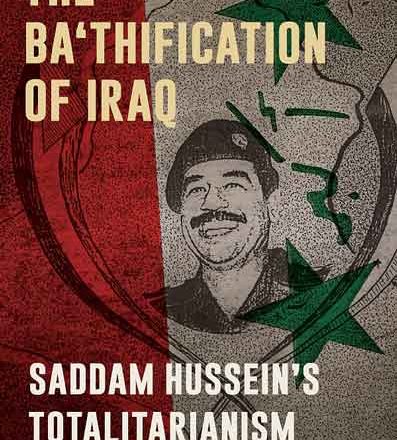A nation must think before it acts.
The Ba‘thification of Iraq: Saddam Hussein’s Totalitarianism, by Aaron M. Faust. Austin: University of Texas Press, 2015. 296 pages
The ability to study modern and contemporary Iraqi history has transformed dramatically over the past few years. Previously, Saddam Husayn’s notoriously closed regime and then the violence that followed the American-led invasion in 2003 had limited the ability of outsiders to find reliable information on the country. However, the opening of Iraqi state and Ba‘th Party archives in recent years presents scholars with a truly unique opportunity. For the first time, academics have full access to the internal files of a modern Arab state. Aaron Faust’s new book, The Ba‘thification of Iraq, uses these files to offer a compelling interpretation of Saddam’s Iraq. In particular, the book makes great use of the Iraqi Ba‘th Party’s secretariat files, which are found in the Ba‘th Regional Command Council (BRCC) collection at Stanford University’s Hoover Archives.
Faust’s primary focus is on a policy that the former regime outlined in an undated, 18-page document titled: “A Work Plan for Coordination between the Party and Mass Organizations in the Field of Ba‘thification of Society.” Helpfully, Faust provides a full translation of this document in the appendix. It lays out a strategy for Ba‘thists to take over Iraqi social institutions, hollow them out, and then transform them into instruments for achieving the party’s political goals. Faust’s book implies that much of BRCC archive deals with how this plan was implemented in different sectors of Iraq society. He includes helpful discussions on the regime’s approach to culture, religion, tribes, and women. In each case he shows how the regime attempted to co-opt Iraqis. Faust also outlines Saddam’s cult of personality as well as his use of terror and enticement. Usefully, Faust describes the regime’s ideology as “Husseini Ba‘thism,” which was similar but not exactly the same as the traditional Ba‘thist ideology that Michel ‘Aflaq had articulated in the mid-20th century. In doing so, Faust is able to demonstrate its consistency on many issues that have confounded other observers of Iraq.
Faust contextualizes Ba‘thist Iraq as a 20th century totalitarian regime. He draws interesting comparisons with Nazi Germany, Stalinist Russia, and other similar cases. Yet, rather than a description of outcomes, he sees totalitarianism as a ruling strategy. Saddam, Faust makes clear, never established absolute control over Iraq. However, the book argues that unlike authoritarian rulers, who simply strove to repress adversarial politics, Saddam attempted to enforce the active support of all Iraqis for his political project. Faust maintains that this ruling strategy, combined with the fact that “the BRCC includes information about so many aspects of life proves that the party constituted the unifying thread within the totalitarian system that Hussein used to control Iraq” (p. xvii).
Inevitably, Faust’s book will be compared with Joseph Sassoon’s recent work, which uses the same sources in a similarly comprehensive study of Saddam’s Iraq.1 Because Sassoon argues that Saddam’s regime was authoritarian rather than totalitarian, one may be tempted to read Faust as contradicting Sassoon. However on closer look, the two works should be read as complementary. Faust and Sassoon conducted their research independently, unaware that the other was working on a similar project. Yet they manage to agree on some of the most important historiographical issues. They both see more consistency in the regime’s ruling strategy than was assumed prior to the release of the archives. Previously, the dominant narrative of 1990s Iraq depicted the Ba‘th Party as receding [End Page 494] in power and being replaced by tribal and religious actors. However, like Sassoon, Faust shows that “By the late 1990s, the Ba‘th statistics demonstrated that the party had regained whatever influence in society it lost and was stronger than ever” (p. 86). Furthermore, Faust agrees with Sassoon and others that, behind closed doors, the regime’s approach toward religion was fairly consistent throughout Saddam’s presidency. This contradicts what was an increasingly popular narrative depicting the…




